Twenty-four hours before my first campervan trip, the only thing I had planned was where to pick up the van. I’d be flying into Las Vegas from San Francisco, collecting a Kuga Campervan from the Travellers Autobarn location off The Strip, and driving east toward Zion National Park, where my friend and I intended to kick off a weeklong road trip through southern Utah.

A Non-Planner’s Guide to #Vanlife: 8 Essential Tips for a Spontaneous Campervan Trip
Twenty-four hours into the trip, our sink sprung a leak, and our demountable table broke, requiring the services of a welder when we reached the town of Escalante. This was one of several hiccups no amount of planning could have preempted.
For spontaneous travelers, #vanlife trips provide a level of freedom that’s unparalleled. You can go anywhere your four wheels will take you, your lodging and basic amenities are built-in, and you can piece together an itinerary around your favorite activities. There are, however, a few realities of vanlife that are worth preparing for in advance.
From one non-planner to another, here are eight van travel tips from an impromptu trip through the Utah desert that’ll help get you hooked on the unfettered vanlife forever.
1. Don’t book campsites. Do download apps.
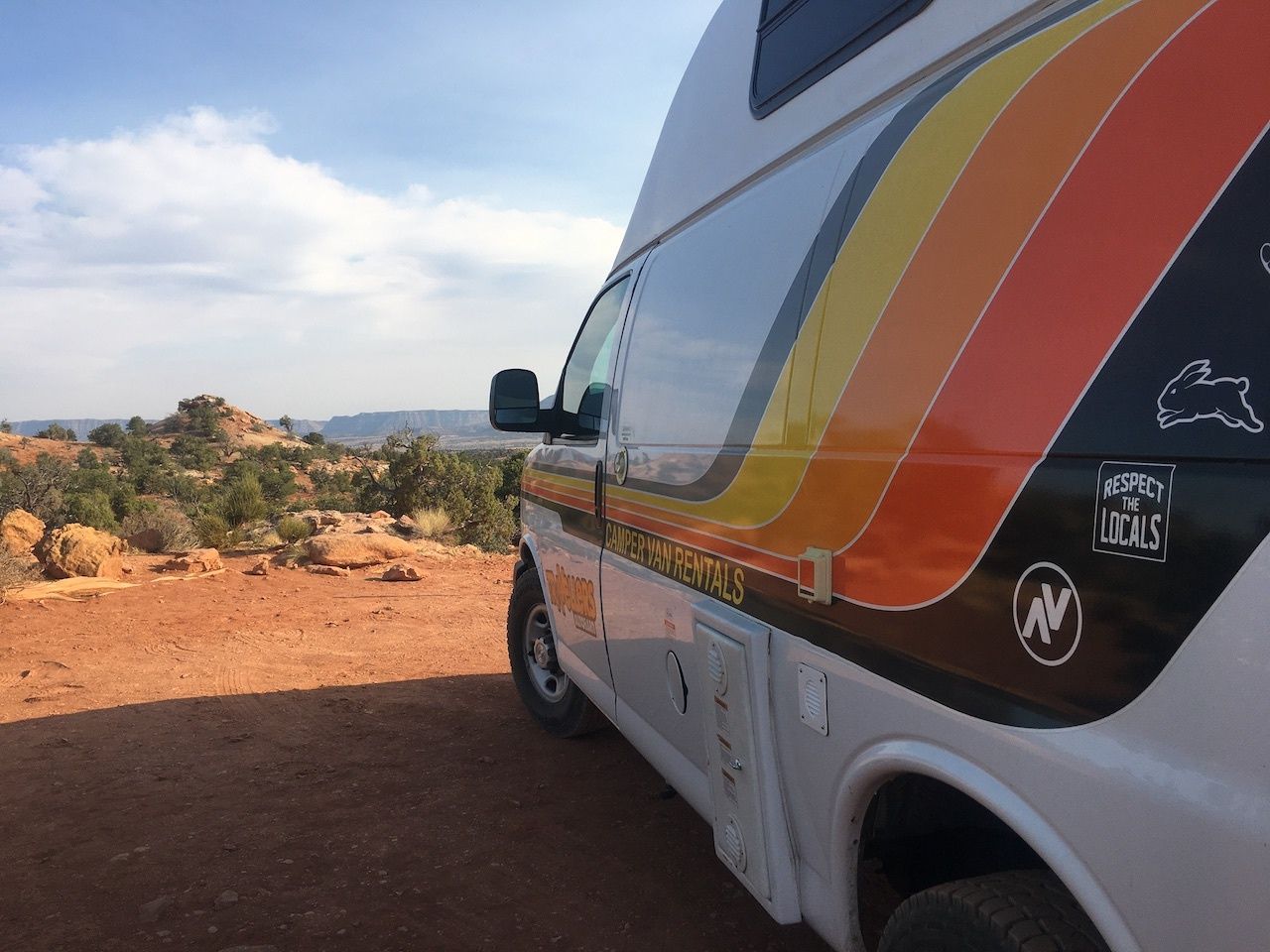
Photo: Alex Bresler
Figuring out where to sleep each night is one of the biggest obstacles spontaneous campervan travelers face. Last-minute campgrounds can be hard to find, fully booked, or prohibitively expensive. Thankfully not all campsites require reservations.
Dispersed camping describes camping outside of an established campground. This is permitted on most public lands managed by the US Forest Service (USFS) and Bureau of Land Management (BLM). Some national and state parks also allow dispersed camping in certain wilderness areas. The rules for selecting a dispersed campsite vary depending on your destination but are generally as follows: Travelers may camp permit- and cost-free at a given site for up to 14 days within a 30-day period provided it’s at least 150 feet from a main road, 100 feet from a stream, and one mile from any designated campgrounds.
Included in our Travellers Autobarn rental was a 90-day free subscription to The Dyrt, a campsite locator service that allows users to filter their search by free sites. This not only helped us find dispersed campsites a stone’s throw from popular national parks such as Zion and Bryce Canyon during peak season, but it also saved us the trouble of attempting any off-roading that our van was not equipped to do. Because most national forests and monuments like Escalante-Grand Staircase are managed by the USFS or BLM, these areas provided us with the greatest number of options and near-total privacy everywhere we parked.
Other resources campervan travelers can use to find dispersed campsites include FreeRoam, iOverlander, and Campendium. More information on camping in specific wilderness areas can be referenced directly on the USFS, BLM, and National Park Service websites.
2. Pack a tent and a tarp, just in case.

Photo: Philip Lange/Shutterstock
Campervans are mobile shelters, rendering tent camping redundant. Nonetheless, there may still be situations in which you’ll appreciate having a tent on hand. Some of the prettiest campsites we discovered required high ground clearance, four-wheel drive, and premium maneuverability. Depending on your van, rugged terrain and narrow roads could be obstacles in claiming ideal campsites that are otherwise accessible on foot. Even in wide-open areas, a tent can offer a reprieve from sleeping in a stuffy van on 100°F summer nights.
Having a tarp nearby is helpful in these situations. It can offer added protection from the elements, be it sun or rain, as well as prevent wear and tear on your tent. For vanlifers, tarps can also be used as makeshift shower curtains, changing stations, picnic blankets, and sleeping bag or duvet buffers if you want to lay out under the stars. Whether you end up using it or not, a tarp is one cheap, compact, multi-use tool that’s always worth loading into your van.
3. Always decide where you’re sleeping before nightfall.
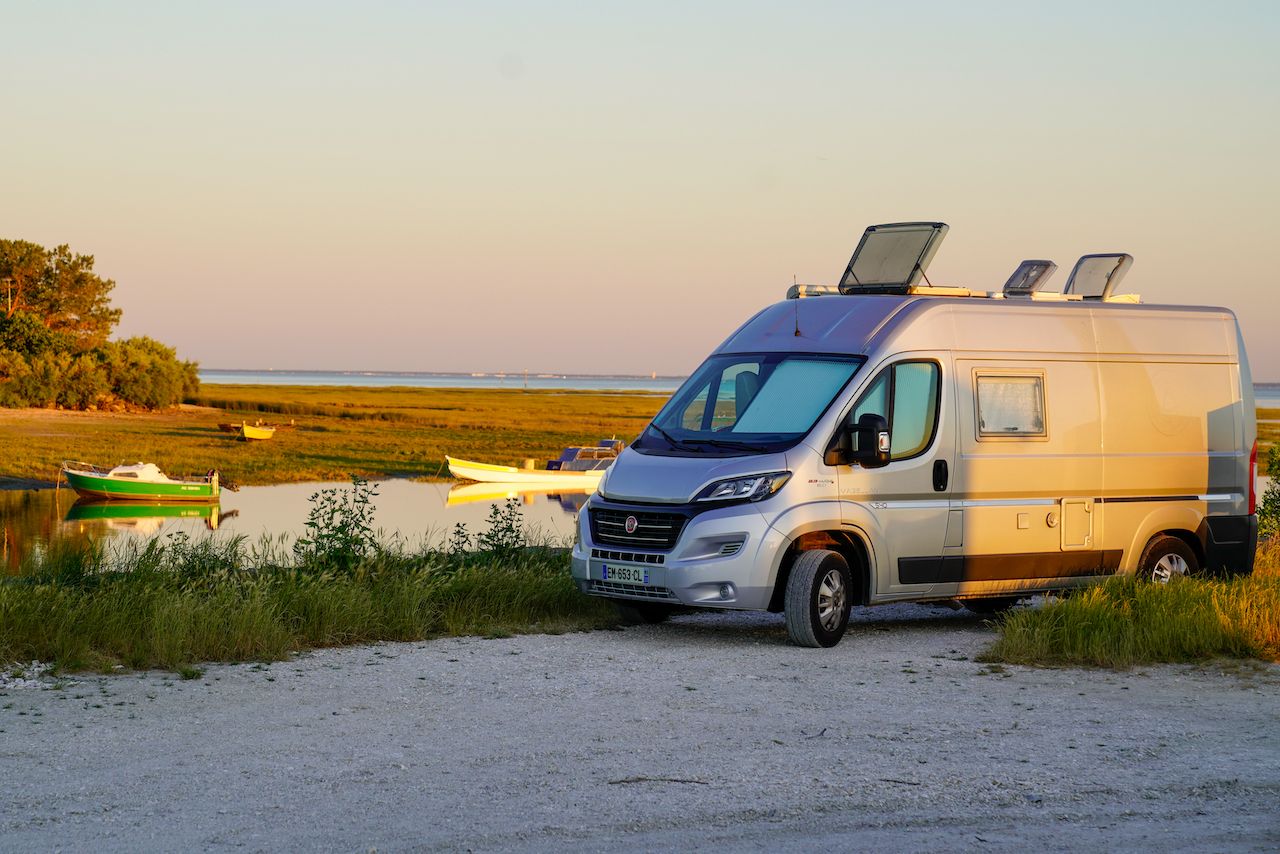
Photo: sylv1rob1/Shutterstock
While campervan trips afford travelers the flexibility to decide where they want to go on a whim, aim to choose your nightly campsites before dusk. In unfamiliar areas, daylight is invaluable for scoping out the terrain, heeding any signage, and setting your camp up safely. Because you’ll most likely be relying on apps and websites to find your campsites, getting a headstart on your search also ensures you’ll have enough cell service or WiFi to find your best option and download offline maps to navigate off-grid areas later on.
Nightfall is less problematic for vanlifers who stick to cities where they can try stealth camping, such as sleeping at a truck stop or in the parking lot of a Walmart, Home Depot, or 24-hour business. You’ll still want to know where these stealth campsites are located lest you end up driving all night in search of one. Beyond finding overnight parking that’s unlikely to get you towed or fined, many cities also have laws about sleeping in your vehicle, so be sure to brush up on what is and is not allowed before settling in for the night in an urban area.
4. Dromedary bags are your best friend.
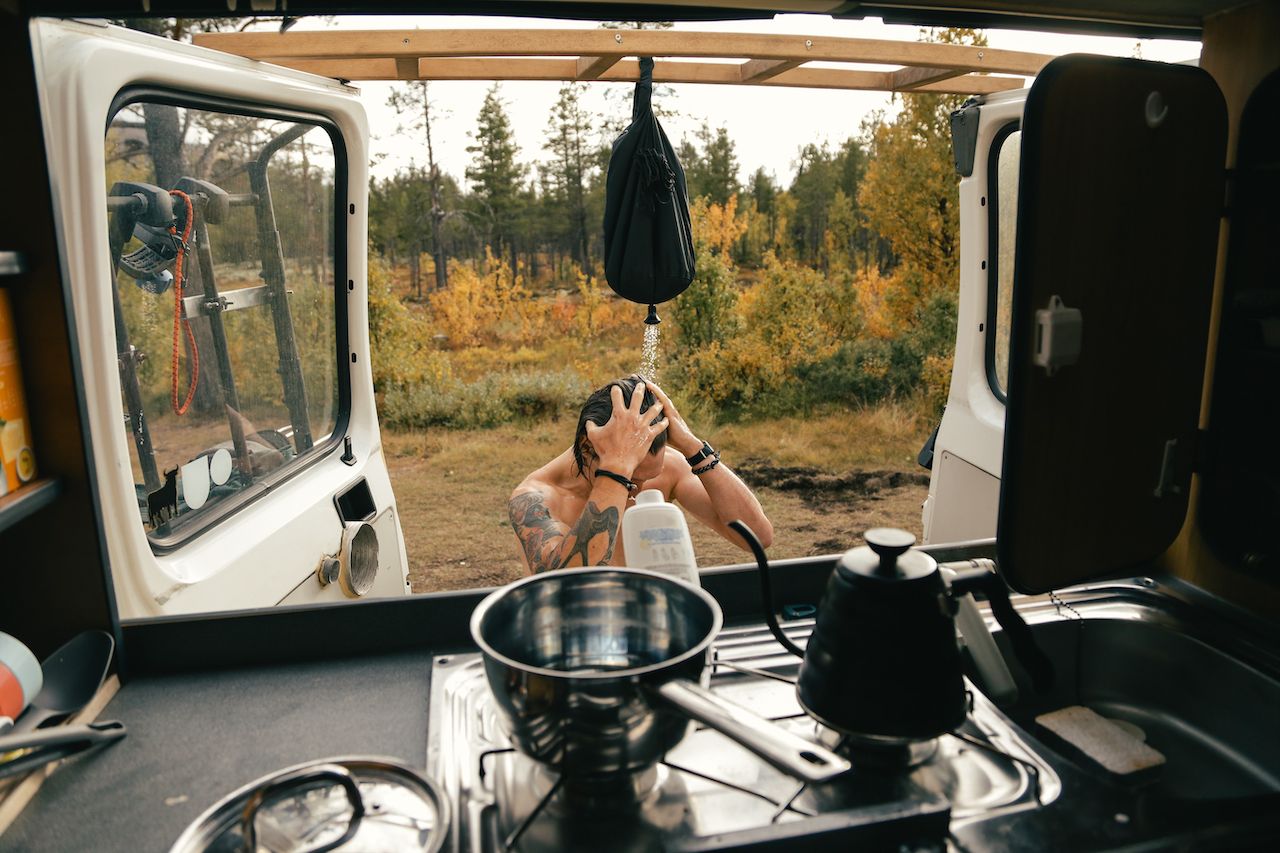
Photo: BublikHaus/Shutterstock
On the road, like anywhere else, water is a vital resource. You need it to stay hydrated, clean, and cool. Even if your campervan comes with running water, that water may not be potable, and your sink will likely be too small to wash much more than dishes. Though vanlifers have discovered many creative ways of keeping themselves and their clothes clean, such as taking advantage of gym passes and laundromats if they’re passing through cities, dispersed campers may not have access to these amenities. Then there’s the issue of plastic waste when it comes to stockpiling your van with store-bought gallons. Enter Dromedary bags.
A Dromedary bag is a hydration bladder similar to a Camelbak, though the largest Dromedary can hold up to 10 liters of water compared to the largest Camelbak’s three liters. Dromedaries are also outfitted with a hanging strap and three-in-one cap that can release both small and large streams, and they can be easily refilled wherever you might top up a water bottle or your van’s water tank. While our Camelbaks were convenient on long, sweltering hikes, our Dromedary was essential, from serving as a water storage system to acting like a faucet before we were able to find the necessary part to fix our sink. It even functioned as a shower we could hang from a tree branch or the back of our van. After all, wet wipes only go so far.
5. If you can, have a high-quality cooler on hand.
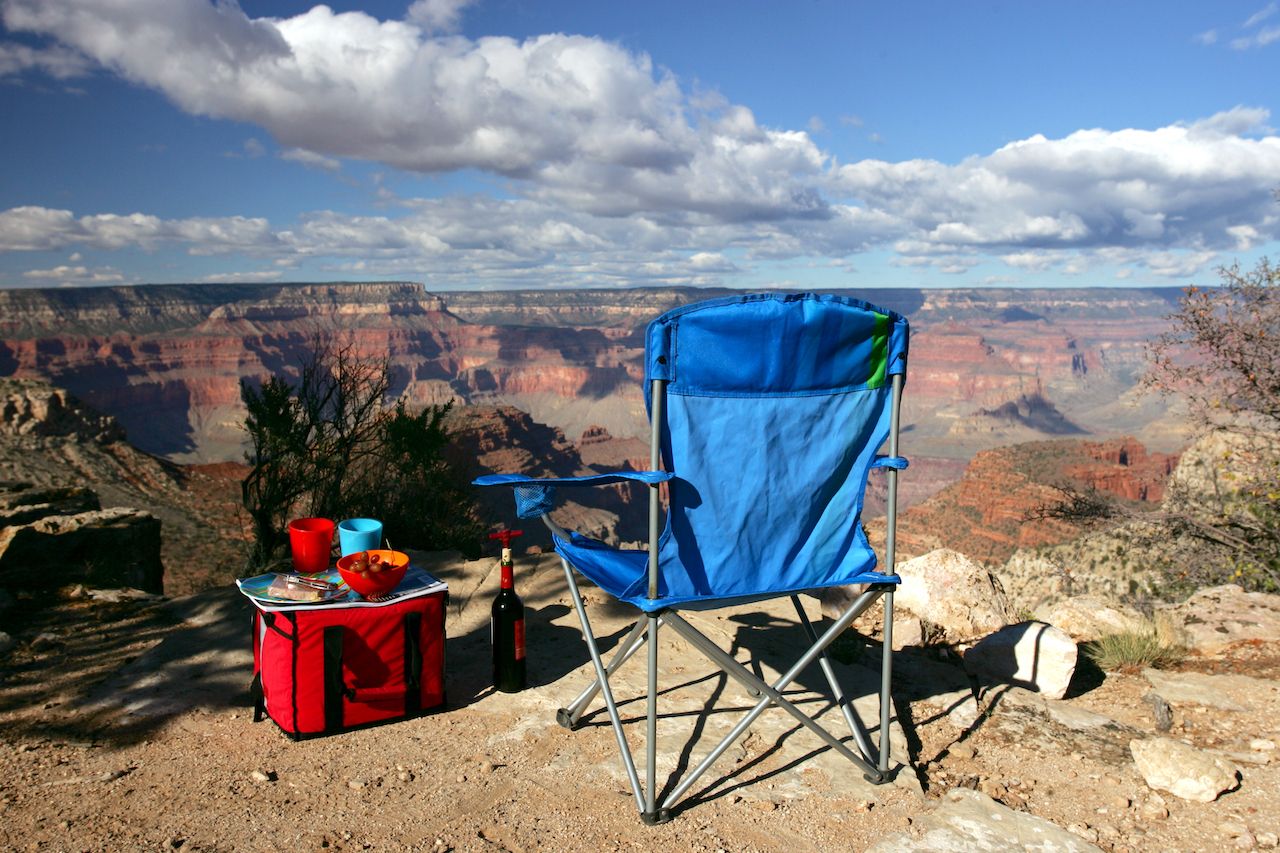
Photo: oksana.perkins/Shutterstock
After a lifetime preparing backcountry meals with basic camping cookware, venturing into the wilderness with a kitchen in tow was a luxury. Our campervan came outfitted with a two-burner gas stove, a solar-powered mini fridge and freezer unit, a small sink, and a microwave for when the van was plugged into a power source. For an additional fee, Travellers Autobarn also provides cooking essentials such as pots and pans, cutlery, and a kettle.
To avoid unnecessary detours and keep our journey as flexible as possible, my friend and I endeavored to make just one grocery run on the first day of our trip. We loaded our pantries with a modest array of spices, condiments, dry goods, and resealable snacks, and we stocked our fridge with long-lasting produce and proteins such as apples, carrots, celery, eggs, and marinated tofu. A few bags of frozen vegetables, a couple of chicken breasts, and a box of veggie burgers just barely fit in the freezer. A few days later our fridge malfunctioned.
Though we were able to meal-plan around any serious spoilage, I found myself wishing we’d brought a cooler on multiple occasions, whether to use as a backup refrigeration unit, cool extra beverages, or simply store loose items while driving. The few coolers we saw on sale at gas stations and country marts mid-trip were made of styrofoam, which are not only less effective but also less sustainable than insulated coolers.
Good-quality coolers can be expensive, but if you plan on making frequent campervan trips, they’re worth the investment. Space is another consideration, though there are enough hard and soft coolers in various shapes and sizes on the market to suit almost any campervan setup. And even if it’s not being used to keep food and drinks fresh, well, what is a cooler if not additional, road-secure, easily organized storage space.
6. Keep an eye on gas prices.

Photo: OleksiyGS/Shutterstock
Gas is expensive, and campervans have big tanks. Fueling up is easily one of the biggest expenses vanlifers can expect to incur on their journeys. While spontaneous travelers may not know where they’re going to be from one day to the next, they can still try to keep costs low. One way to do this is to let favorable gas prices decide when you should fuel up, not the emptiness of your tank. Google Maps can also help. Often, the price per gallon is listed when you search for nearby gas stations, and the difference between neighboring stations can be significant. A 50-cent disparity may not seem like much when you’re looking at the map, but if your tank holds roughly 26 gallons, those savings will start to add up quickly.
7. Stock up on beer, even if you don’t drink.

Photo: Dean Drobot/Shutterstock
In a campervan, all the most useful gear serves multiple purposes. In the kitchen, for example, an eight-quart pot can be used as a saucepan, a skillet, a kettle, and a mixing or serving bowl, as well as an empty vessel to keep other items tidy when they’re not in use.
Beer is not the first thing that comes to mind when we think of gear. Sure, cracking open a cold one after a long drive or hike is a simple pleasure for those who drink, yet even for those who abstain, beer can be handy if you’re comfortable keeping it around. It can be used to tenderize meat, which is wont to get overcooked on a propane stove. One of our favorite dinners was the result of a half-drunk Modelo Chelada Tamarindo Picante, which we repurposed to marinade chicken in lieu of buying spices we would hardly put a dent in. Resourceful chefs can also use tasty craft beer as a simmering liquid, the base for a sauce, or a flavoring agent for one-pot meals such as chili. Because it’s yeasted, bakers can even whip up simple bread using beer.
Carbonation and acidity are two more boons. On one occasion, I used beer to remove rust from metal utensils, letting them soak as the bubbles broke down the unwanted oxidation. I’ve also used beer to put out campfires without depleting my water supply, as the alcohol content in most brews is not high enough to catch fire. Though I’ve not tried these hacks myself, I’ve even heard of people using beer to shampoo their hair or soak their feet after long hikes. Odd? Maybe. But people pay good money at beer spas, and we could all use a little pampering on the road.
8. When in doubt, stop at an RV park.
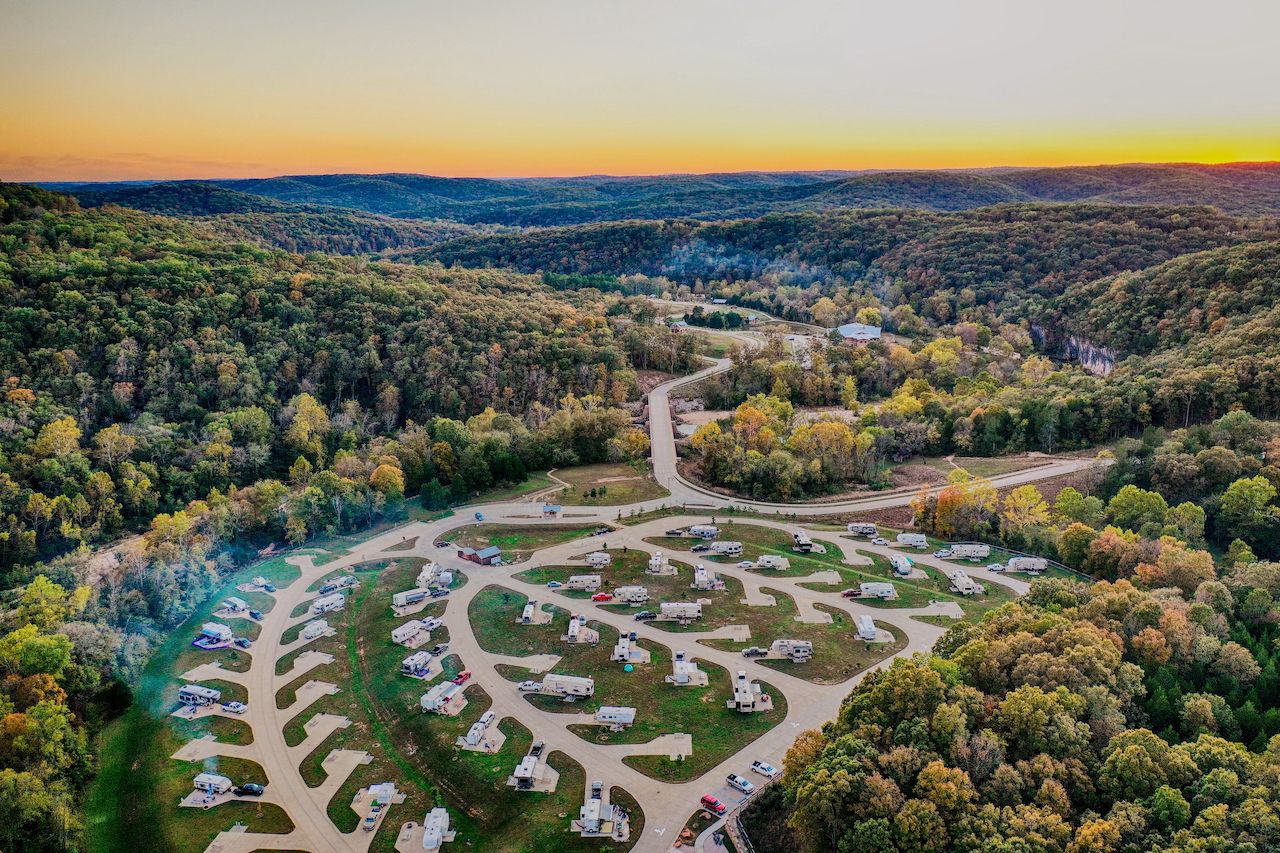
Photo: Skatie Designs/Shutterstock
Long before #vanlife started trending on Instagram, RV travel was a way of life. This explains why there are RV parks located near so many of the most popular national parks and attractions. For campervan travelers, these outposts are an invaluable resource. The staff, and many of the patrons, are well-versed in the road-trip lifestyle and generally happy to give directions, answer questions, and offer help. Unless an RV park is full, campervan travelers may also be welcome to plug in, empty or fill their water tanks, and even spend the night.
On the one occasion we were turned away from an RV park because there was no water refill station available, the attendant directed us to a small state park down the road. We had to pay a modest fee for a day pass, which gave us access to all the basic amenities we had forgone in our week of dispersed camping. We dumped our gray water, topped up our tank, refilled our Dromedary and Camelbaks, and even stayed for a spontaneous lake SUP session. Unlike big-name national parks, smaller city, county, state, and regional parks are a cheap, uncrowded, and stress-free wealth of resources and recreation.
Knowing when and where to ask for help is one of the best things campervan travelers can do to ensure they have the safe and responsible journeys of a lifetime. Strike the right balance between being prepared and keeping your plans loose, and there’s nothing better than hitting the open road with nothing but your van, a little travel savvy, and an appetite for adventure.